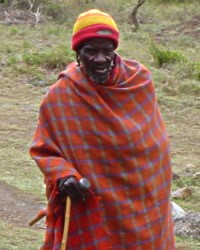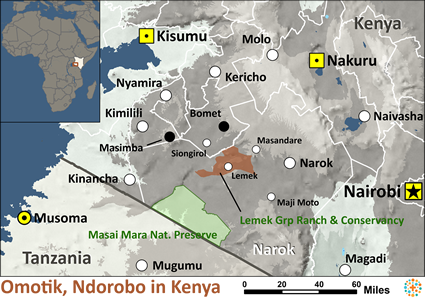Sliding through the dense forest, the mud-covered young Dorobo hunter stiffened suddenly as he heard unfamiliar voices ahead. Creeping forward, he spied a group of oddly dressed people talking to his fellow tribesmen. "Is this really the end of the world, is this the Jesus they talk about?" he pondered. Curious, he stepped into the clearing and walked cautiously toward them. He had just seen the first Jesus-sent people to his own home.
As fate would have it, this group of people acquired the name Dorobo, which means "those who have no cattle." They are comprised of several small forest dwelling hunter groups in the plains of the Rift Valley and in the forests of the neighbouring escarpments. On recognizing the unity of the various groups, the British colonial government grouped them together as one. Dorobo in general are a strong and resilient people who quickly adapt to material cultures and languages of their neighbours if their survival demands it.
However, while they may seem like a non-existent group of poverty-stricken people, one Dorobo sub-group, the Ogiek, have attracted unusual international attention by claiming their own rights. They have formed an organization that maintains a website to champion their rights.
The Dorobo groups include the Ogiek, the Mukogodo, the Kinare, the Omiotik, the Aramanick, the Chamus, the Maasai Dorobo and the El Molo. They are said to have originated from eastern and southern Cushites. They are basically people groups who adopted a different way of life when their own ceased to exist. Their customs vary following the dominant culture patterns of the Nilotic people. They speak a dialect of Kalenjin and have cultural tendencies similar to Kipsigis.
The individual groups follow a variety of unique patterns of living. The Ogiek live in the Mau forest. They are also referred to as Okiek, which means hunter/gatherer. They are believed to be originally Kalenji linguistically, but some of them have adapted more closely to the Maasai, others to Kipsigis. Whereas the life of the Kalenjin is connected to cattle herding, Ogiek life is linked to honey and bee culture that plays a central role in their day-to-day activities.
The Mukogodo live in the Mukogodo forest of west central Kenya. They have completely assimilated into the Maasai culture and language. They consider themselves a sub-tribe of the Maasai and speak the Maa language, though the older generation still speaks Yaaku, the Mukogodo's Cushitic language. The El Molo are said to be related to the Somali and Rendille.
The Kinare are generally treated as Kikuyu due to their settlement near the Kikuyu on the eastern side of the Rift Valley. They do not use the ancient language. The Omiotik and Aramanick are bilingual in Maasai and Swahili and the Chamus or Njemps speak Samburu.
Some Dorobo have taken to different lifestyles than they traditionally practiced. The Maasai Dorobo constitute and ironworking clan of the Maasai, while the Mukogodo Maasai are herders and raiders in the central Maasai tradition. The El Molo fish in the Lake Turkana while some have adopted the activities of their host culture though at a limited scale. From a life of pastoralists, those that settle near water area become fishermen or beekeepers. They make bows, arrows spears, baskets and pottery for both domestic and economic purposes.
The majority of the Dorobo groups are not closely knit and have no significant central authorities to govern them. This is because their lifestyles are subject to change; they are constantly moving in order to keep up with their environment and make best use of it. They do, however, demonstrate cooperation when it comes to hunting, gathering and collecting honey. Family roles and relationships go beyond prescribed norms. Their juniors respect elders and age mates treat one another as brothers and sisters.
The Dorobo maintain various forms of traditional animistic religion, while some have accepted the Christian faith as their Nilotic neighbours have. Many of the Ogiek groups refer to God as Tororr meaning "very high," while some living among the Nandi and Kipsigis refer to Him as Asis.
The Gospel has been presented in various ways including radio broadcasts. However, the lack of Christian literature, including the JESUS Film, poses a major challenge. The pastoral nature of the Dorobo, combined with the fact that they exist in so many diverse groups, makes reaching them extremely difficult. Assessment is now ongoing to evaluate how many Dorobo groups require literature of their own. A few Christian missions are working with native missionaries to evangelize the Dorobo peoples.
Additional missionaries to work among these marginalised groups.
Access to formal education.
Security problems.
Good infrastructure and health facilities.
Access to clean water.
Language surveys to determine the best languages to reach these people using literature.
Scripture in the languages/dialects they use best.
Ask God to send missionaries who are ready to live and work with these communities.
Pray that there would be resources to do survey among these people.
Pray that there would be resources to do survey among these people.
Pray that God would reveal Himself to these people.
Pray that they will start being incorporated in the development and be lifted from their economical situation.
Scripture Prayers for the Omotik, Ndorobo in Kenya.
The Unfinished Task - Profiles of Kenya's least Reached Peoples, Nairobi, Kenya: ACM FTT (Africa Centre for Missions Finish the Task), 2004. pp. 29-32
| Profile Source: Anonymous |

























